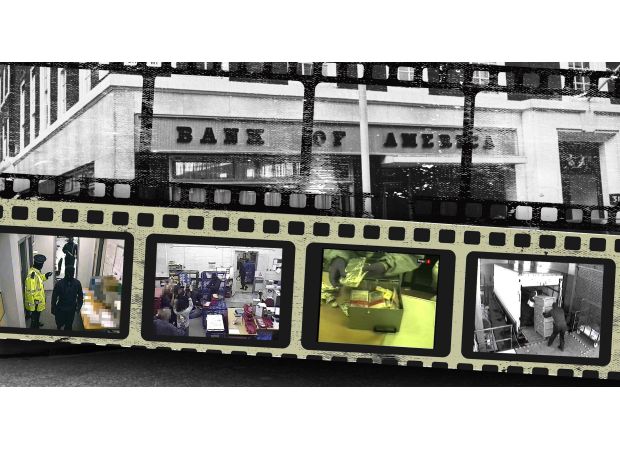Bank robbers attempting to steal £8 million were foiled in their final attempt, becoming a crime of the past.
Other than the Great Train robbery, Baker Street heist and Bank of America burglary, what other crimes are on Metro's list?

In the 21st century, heists have become increasingly rare. However, there was a time when they were more common, and one of the most notorious heists in history happened in Mayfair almost 50 years ago. In 1975, robbers managed to steal a whopping £8 million from Bank of America, making it the largest bank burglary ever at the time. What makes this heist even more intriguing is the fact that the mastermind behind it, Stuart Buckley, is still at large.
Buckley was hired as an electrician at the bank's Mayfair branch, and little did the bank know that this decision would end up costing them £7.5 million. Despite having just finished a prison sentence for handling stolen goods, Buckley managed to gain the trust of his superiors and was given keys to the building. This allowed him to plan the heist with his old friend and experienced criminal, Frank Maple.
The gang of eight men met in a cafe near the bank to discuss their plans. One of the main challenges they faced was figuring out the passcode to the bank's vault. Buckley was given the task of obtaining this information, and he did so by secretly observing the bank manager as he entered the code. With the passcode and keys in hand, the gang successfully carried out the heist, stealing millions of pounds worth of cash, jewelry, and other valuable items.
However, their success was short-lived as the police were able to quickly identify the robbers. This was thanks to a tip-off and the fact that the police had been keeping an eye on Maple and his gang prior to the heist. Buckley, who had turned informant after his arrest, provided the police with all the details about the heist and his co-conspirators. As a result, most of the gang members were sentenced to long prison terms, while Maple managed to flee the country and evade capture.
The robbery received extensive media coverage, and Scotland Yard launched an investigation to find the culprits. However, as cash becomes less prevalent in society and electronic banking becomes more common, large-scale robberies like this one are becoming increasingly rare. According to crime expert Howard Sounes, bank robberies are now seen as a crime of the past, with electronic fraud being the modern-day equivalent.
Despite the thrill and intrigue surrounding heists, they often end in failure and imprisonment. This is evident in another famous heist in British history, the Great Train robbery of 1963. The robbers were given inside information by an anonymous source known only as "The Ulsterman," and they almost succeeded in stealing a large sum of money. However, most of them were eventually caught and sentenced to long prison terms.
In the 21st century, heists may not be as common as they once were, but they still capture our attention and imagination. They provide a glimpse into a world of daring and intrigue, where the risk of getting caught is high, but the potential payoff is even higher. However, as technology advances and cash becomes less prevalent, it's likely that we will see fewer and fewer of these thrilling heists in the future.
Heists have become increasingly rare in the 21st century, but back in 1975, there was one that made headlines all over the world. It was a bank robbery that took place in Mayfair, and it was one of the biggest of its time. The robbers managed to get away with £8 million from the Bank of America, making it the largest bank burglary ever.
The mastermind behind this heist is still at large today, almost 50 years after it happened. His name is Stuart Buckley, and he was an electrician employed by the bank at the time. Little did they know, Buckley had just served a nine-month prison sentence for handling stolen goods, which the bank failed to check before hiring him. This allowed him to gain the trust of his superiors and have access to the building.
Buckley then met with an old friend and convicted criminal, Frank Maple, to plan the heist. Maple put together a gang of eight men, and they met at a cafe near the bank to discuss their plans. The only obstacle they faced was getting the vault's passcode, which Buckley was tasked with finding out. He managed to do so by hiding in the ceiling above the vault and eavesdropping on the bank's manager.
On April 24th, 1975, the gang, dressed in business suits, confidently walked into the bank armed with keys and the passcode. In a matter of minutes, they opened the vault and made off with the £8 million in cash, jewelry, and other valuable items. However, the robbery did not go unnoticed, and Scotland Yard immediately launched an investigation. The media coverage of the heist was extensive, and the police received a tip-off about Maple and his gang, leading to their eventual arrest.
Buckley, who was the mastermind behind the heist, turned informant after his arrest, leading to the downfall of his co-conspirators. They received jail sentences totaling nearly 100 years, with Buckley only serving seven years for his cooperation. Maple, on the other hand, managed to flee the country and is believed to be hiding in Morocco, a country with no extradition treaty with the UK.
However, the police only managed to recover £500,000 of the £8 million stolen, and Maple was never convicted for the robbery. This heist, along with others like it, has become increasingly rare in the 21st century. According to crime expert Howard Sounes, bank robberies are considered a crime of the past due to the prevalence of electronic banking and credit cards. He believes that internet fraud is the modern equivalent of a heist, but it doesn't have the same allure and intrigue as a bank robbery.
The Great Train robbery of 1963 is another notable heist in British history. The robbers, led by Bruce Reynolds, managed to steal £2.6 million from a mail train, making it the largest robbery of its time. The gang was aided by an anonymous informant known as "The Ulsterman," who provided them with inside information. Despite their successful heist, most of the robbers were eventually caught and sentenced to long jail terms.
In the end, heists like these may have been thrilling and intriguing, but they are becoming increasingly rare in the modern world. With the rise of electronic banking and credit cards, it has become a high-risk crime with little reward. Despite this, the allure of a dramatic and daring bank robbery continues to captivate the public's imagination.






